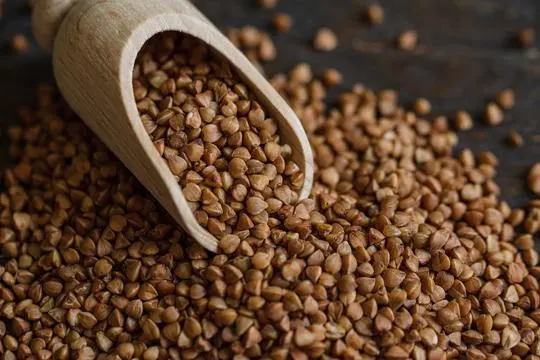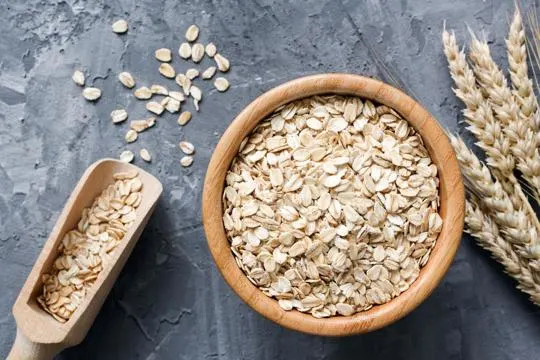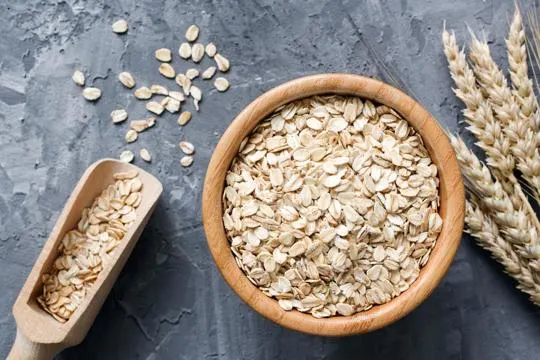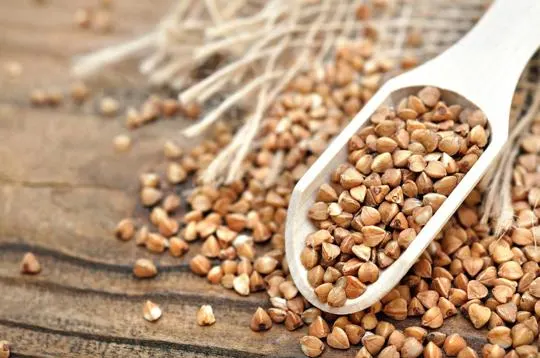Buckwheat and oats reign in the breakfast world. Both are giants in health benefits, yet they’re not twins.
Buckwheat, despite its name, is a relative of rhubarb. Surprise! Not even a real wheat. Oats? They’re the morning staple we’ve all tried, loved, or spiced up with a million toppings.
Our mornings often start with this dilemma. Team Buckwheat or Team Oats? Here’s the scoop. Buckwheat boosts heart health and controls blood sugar. Oats bring fiber to the table, making our guts happier.
We’ve all had those “oops” moments. Think cooking buckwheat and ending up with mush. Or transforming oats into something wallpaper glue could envy. This article sheds light, offering insights we’ve gathered from kitchen triumphs and disasters alike.
What is Buckwheat?

Buckwheat is not related to wheat, but it has its own unique triangular shape and nutty flavor.
It’s packed with essential nutrients.
Fiber, protein, vitamins – it’s got it all.
Plus, it’s gluten-free, so great for those with sensitivities or celiac disease.
It also has antioxidants that support heart health and reduce cholesterol.
As for taste, buckwheat has an earthy flavor.
You can use it in pancakes, noodles, porridge and more.
So if you’re looking for something new and nutritious, buckwheat is the way to go.
What are Oats?

Oats are a popular cereal grain that are renowned for their nutritional value and versatility.
Harvested from oat plants, they can be consumed in various forms such as rolled oats, steel-cut oats, or oat flour.
Oats boast a nutty flavor with a hint of sweetness, and are soft and creamy when cooked – perfect for porridge and baked goods.
What really sets oats apart is their fiber content.
This soluble fiber helps reduce cholesterol and improve heart health.
It also promotes digestion and a feeling of fullness, making oats great for weight management.
Additionally, they are packed with essential nutrients like manganese, phosphorus, magnesium, zinc, iron, and B vitamins – all contributing to strong bones, improved brain function, energy production, and overall wellbeing.
Incorporating oats into your diet is an excellent way to reap their many health benefits.
Whether you prefer porridge for breakfast or want to add some bulk to your baking, oats are an ideal choice for maintaining a balanced diet.
Differences Between Buckwheat and Oats

Buckwheat and oats are two different grains with many nutritional advantages.
Origin and Plant Characteristics
Buckwheat and oats are grains, but with different origins and plant features.
Buckwheat’s birthplace: Central Asia.
Oats come from Eurasia.
Buckwheat grows best in cool climates, like in Russia and China.
Oats prefer temperate weather with reasonable rainfall.
Buckwheat plants display broad leaves and white flowers.
Oats have thin leaves and spiky flowers.
Even so, both grains offer health benefits and make tasty meals.
Nutritional Composition
At first glance, buckwheat and oats seem similar.
But, when it comes to nutrition, they are quite distinct.
Buckwheat is packed with protein, fiber, and essential amino acids.
This makes it great for vegetarians and vegans.
Oats are rich in beta-glucan.
This type of soluble fiber helps lower cholesterol.
Oats also contain antioxidants and give a steady energy release throughout the day.
Despite these differences, both grains offer many health benefits.
So, choosing between them depends on your dietary needs and preferences.
Explore the variety that these grains offer for your table.
Texture and Taste
The texture and taste of buckwheat and oats differ greatly.
Buckwheat has a crunchy, chewy texture and an earthy, nutty flavor.
Oats, on the other hand, are smooth and sweet.
These special characteristics make them perfect for recipes or dietary requirements.
Buckwheat’s texture is crunchy yet chewy.
It adds depth to dishes like pancakes or porridge.
It absorbs flavors well and can be used in savory or sweet recipes.
Plus, it holds moisture when baking, resulting in moist treats.
In contrast to buckwheat, oats have a velvety texture.
They can be cooked as oatmeal or used in baked goods.
Oats are naturally sweet and pair well with mix-ins like fruits, nuts, or honey.
More details worth mentioning: buckwheat is not a grain, but a pseudo-grain.
Also, it is gluten-free.
Oats can be gluten-free too, if certified gluten-free oats are chosen.
In conclusion, buckwheat has a hearty texture and nutty flavor.
Oats have a smooth texture and delicate sweetness.
Understanding these grains’ unique qualities allows for creativity in making dishes suited to individual tastes or dietary needs.
Cooking and Culinary Uses
Buckwheat and oats are both popular in the kitchen.
Buckwheat has a nutty, earthy taste, perfect for savory dishes like pilafs or salads.
Plus, it’s gluten-free, so perfect for those with dietary restrictions.
Oats have a comforting, creamy texture.
We use them for sweet dishes like oatmeal cookies, granola bars, and breakfast cereals.
Oats can also be ground into flour for baking.
Buckwheat cooks just like rice or quinoa.
It takes on different flavors easily and absorbs seasonings.
To cook oats, simmer in water or milk until desired consistency.
Buckwheat is common in Eastern European dishes, like kasha or soba noodles.
Oats are found in Western dishes, like apple crumbles and overnight oats.
Nutritionally, buckwheat has more protein and fiber than oats.
It’s also a great source of magnesium and manganese.
Oats contain beta-glucan, which helps lower cholesterol.
Similarities Between Buckwheat and Oats

Buckwheat and oats have much in common nutritionally and in terms of versatility.
Both are gluten-free and provide dietary fiber, which helps with digestion.
Plus, they contain minerals like magnesium, iron, and zinc that keep us healthy.
In recipes like pancakes, porridge, and baked goods, they can be swapped in for each other, great for all sorts of dietary preferences.
Cooking-wise, they can both be boiled or steamed to be super soft and fluffy.
Or they can be ground into flour for a variety of uses.
To sum up, buckwheat and oats are distinct yet similar, making them a great addition to any diet.
Health Benefits of Buckwheat and Oats
Buckwheat and oats are two popular grains that offer many health advantages.
Both are full of nutrients and can be incorporated into a healthy diet.
Here are the top health benefits of buckwheat and oats:
- Buckwheat is gluten-free, perfect for those with gluten intolerance or celiac disease. It’s a great source of protein and contains all nine essential amino acids.
- Oats are known for their high fiber content, which helps digestion and prevents constipation. They also contain beta-glucan, a type of soluble fiber that has been linked to lower cholesterol levels.
- Both buckwheat and oats are packed with antioxidants, which protect the body from harmful free radicals. Antioxidants are associated with a lowered risk of chronic diseases like heart disease and certain types of cancer.
- Buckwheat contains magnesium, which is important for nerve function, blood pressure regulation, and bone health. Meanwhile, oats are rich in iron, which helps produce red blood cells.
- Buckwheat contains rutin, a compound that improves blood circulation and lowers blood pressure. Oats have anti-inflammatory properties, reducing the risk of chronic inflammation-related diseases.
Plus, both buckwheat and oats are easy to incorporate into your diet.
Buckwheat can be used to replace rice or wheat in dishes like salads or stir-fries.
Rolled oats can be eaten as oatmeal or added to smoothies.
So if you prefer the nutty flavor of buckwheat or the comforting taste of oats, both grains have valuable health benefits.
How to Incorporate Buckwheat and Oats in Your Diet?
Incorp’ing buckwheat and oats into your diet could give meals a nutritious boost.
Here are 3 creative and easy ideas to get these two versatile ingredients into your daily eating:
- Start the day with a hearty brekkie using oats. Enjoy a bowl of oatmeal topped with nuts, fruits or honey for extra flavor and nutrients. Or, blend oats into smoothies or add them to pancake batter for a healthier twist.
- Buckwheat can be used to replace traditional grains in dishes like stir-fries, salads and soups. It has a nutty taste and unique texture, plus essential amino acids and minerals.
- Make some homemade energy bars or granola with both buckwheat and oats for a tasty and convenient snack. Customize with dried fruit, seeds, or choc chips. Perfect for on-the-go or post-workout.
You could also explore recipes specifically designed around buckwheat or oats.
Porridges, cookies, bread – the options are endless for experimenting with these nutritious grains in cooking.
So why not give them a go today?
Conclusion
In short, buckwheat and oats are two distinct grains.
Both have tons of potential uses, each having their own nutritional benefits.
Oats are a gluten-free, whole grain with more fiber than buckwheat.
Still this doesn’t mean that they can’t both be enjoyed side by side to get the maximum health benefits from each one.
While one variety may fit better for someone’s individual diet needs, it is important to not overlook buckwheat as a great complement to all the recipes where oats are commonly used.
Be sure to keep an open mind when it comes time to decide which grain is the best fit for your meal plan –– you don’t need to limit yourself.
It’s always worth doing some research so you can make food choices that truly nourish and benefit your body in the long term.

Leave a comment